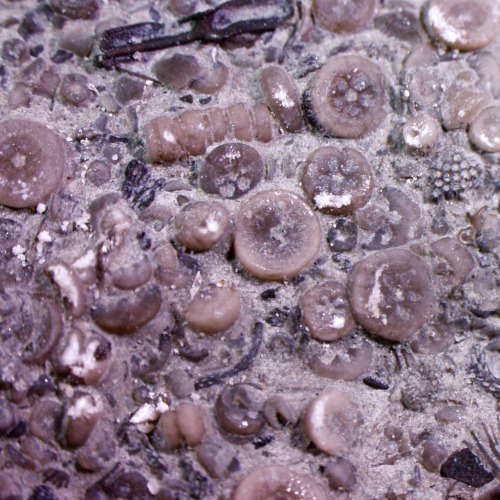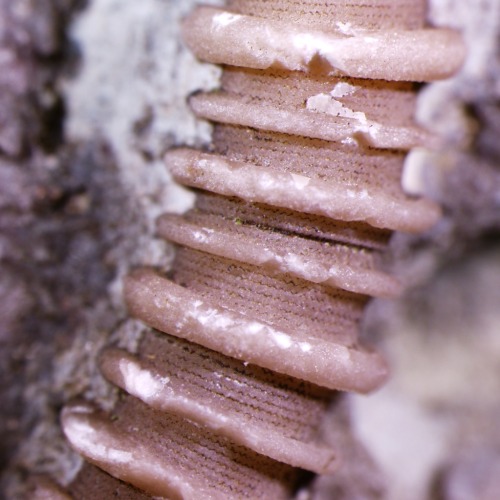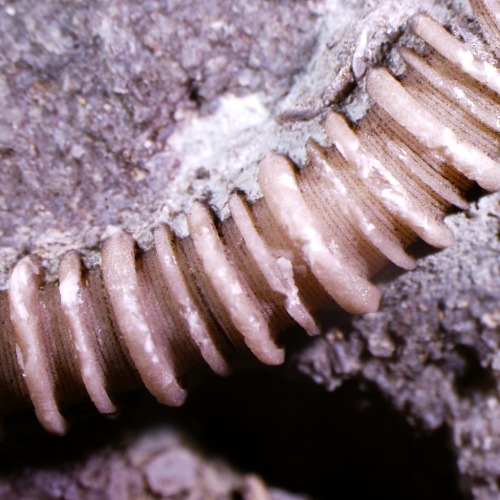#crinoids
I collected these crinoid stems in northern Kentucky a few weeks ago. And while they are aquatic invertebrates like everything else on this blog, they are 450 million years old… unlike everything else on this blog.
Adults in the class Crinoidea, or sea lilies, attach to the ocean bottom with these stems. The stems are quite common to find in high densities; sometimes they make up entire limestone beds. The arms and calyx of the lilies are much more difficult to find.
The fossil beds in Kentucky can be found along most road cuts and behind recent developments. It is solidly in the Ordovician period.
Post link
Changing it up briefly tonight! I collected these crinoid stems in northern Kentucky a few weeks ago. And while they are aquatic invertebrates like everything else on this blog, they are 450 million years old… unlike everything else on this blog.
Adults in the class Crinoidea, or sea lilies, attach to the ocean bottom with these stems. The stems are quite common to find in high densities; sometimes they make up entire limestone beds. The arms and calyx of the lilies are much more difficult to find.
The fossil beds in Kentucky can be found along most road cuts and behind recent developments. It is solidly in the Ordovician period.
Post link
A spectacular, 10.5" plate of twelve detailed fossil crinoids and a gastropod of the species Platyceras acutirostre (#93), collected from Crawfordsville, Indiana. These fossils have been microscopically prepared using air abrasives, revealing their intricate details and three dimensional preservation.
It is believed that crinoids from the Ramp Creek Limestone were buried in sediment from nearby deltas during storms. The resulting siltstone deposits are soft enough that fossils can be extracted in exquisite, three-dimensional relief.
Source: https://www.fossilera.com/fossils/10-5-fossil-crinoid-plate-six-species-crawfordsville-indiana
Post link
#FossilFriday: Crinoids (Genus Encrinus) lived during the Middle Triassic Epoch. #SciArt from Curso Elemental de Zoología (1898) by Henri Milne-Edwards, translated into Spanish by Elías Zerolo. Contributed for digitization in #BiodiversityHeritageLibrary by Dirección de Bibliotecas, Universidad Autónoma de Nuevo León @uanlred. https://biodiversitylibrary.org/page/54364278
_________________________________________________
#Fossils #Triassic #Crinoids #BHLib #Biodiversity #NaturalHistory #NatHist #ScientificIllustration #ScientificArt #OpenAccess #Libraries #Archives #SpecialCollections #LibrariesofInstagram #IGLibraries #IG_Libraries #UANL #BHLMexico
Post link







My samples are here and I’ve got some new patterns up! I’m splitting them into 3 separate posts.
The first one I drew is this black & white crinoid fossil pattern copied from a 1760’s teapot from The Met’s collection. The Milwaukee Art Museum has a nearly identical one, also 1760’s, and at first I’d assumed they were heavily stylized but it turns out that slices of crinoidal limestone really do look like that. (source for the last picture) Looking at pictures of crinoid fossils I found matches for almost every single motif in the teapot, and was amazed.
I drew my pattern with a smallish felt tipped pen and did the dots in between with a sharpie. This is the first historical pattern I’ve ever copied (not from fabric, but it’s still a historical pattern) and I doubt anyone would ever guess it was 18th century.
It’s on Spoonflower,MyFabricDesigns, and Redbubble.








